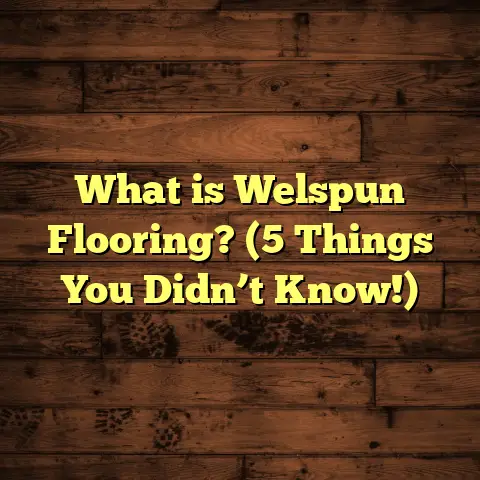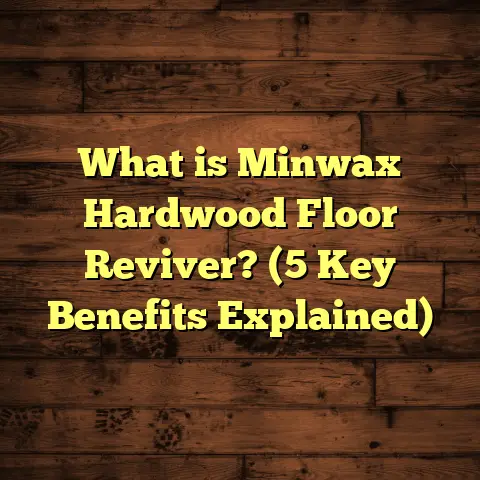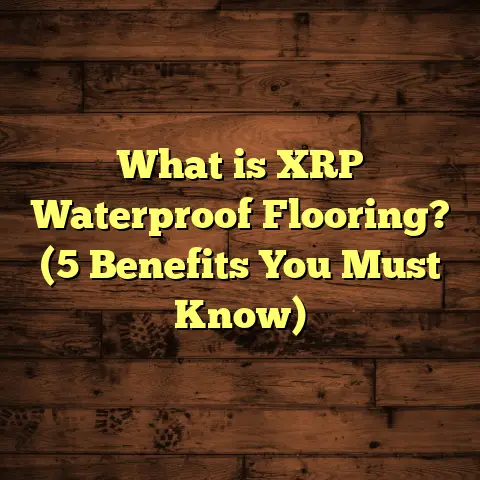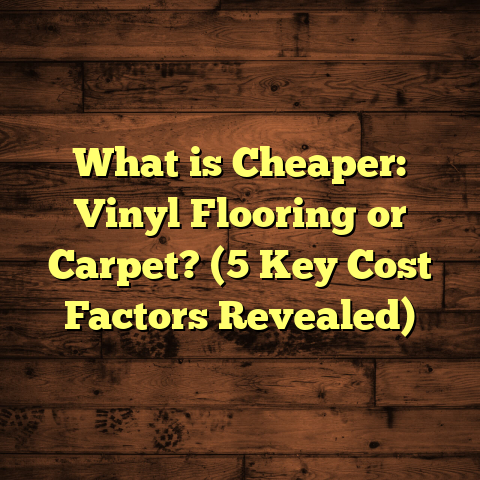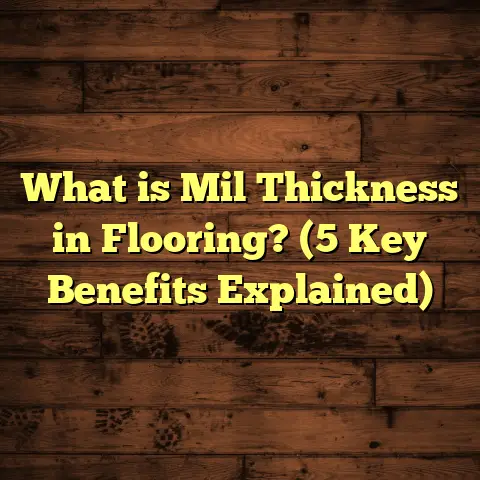What is Shaw Luxury Vinyl Plank Flooring? (5 Reasons to Choose It)
A trendsetter’s choice often reflects a blend of style, function, and practicality. When it comes to flooring, I’ve noticed more and more homeowners and interior designers are turning their attention to Shaw Luxury Vinyl Plank (LVP) flooring. What draws them in is the way this flooring brings together the warmth and beauty of hardwood with resilience and ease that modern living demands. I’ve worked with Shaw LVP on countless projects, both in my own home and for clients, and what I’ve learned is that it’s not just a passing fad—it’s a smart choice for many lifestyles.
What is Shaw Luxury Vinyl Plank Flooring?
Let’s start with the basics: what exactly is Shaw Luxury Vinyl Plank flooring? Shaw LVP is a type of resilient flooring designed to replicate the appearance of hardwood floors while offering benefits that wood can’t always deliver.
Shaw Floors is a reputable company with decades of experience in flooring manufacturing. Their luxury vinyl plank line uses advanced technology to create planks that look and feel remarkably like real wood. The product itself consists of multiple layers:
- Wear Layer: This is the top protective layer that resists scratches, stains, and general wear.
- Design Layer: Beneath the wear layer lies a high-resolution image layer that mimics the grain, knots, and color of different wood species.
- Core Layer: This provides stability and durability. Shaw offers different core options, such as rigid core (which includes SPC – Stone Plastic Composite) or flexible core, depending on the product line.
- Backing Layer: The bottom layer helps with moisture resistance, sound absorption, and sometimes includes an attached underlayment for easier installation.
What makes Shaw LVP stand apart from many other vinyl options is its attention to detail in texture and appearance. The embossing techniques used create surface textures that correspond with the wood grain pattern in the design layer. This means when you run your hand over the floor, you don’t just see wood—you actually feel it.
I remember installing Shaw LVP in my own kitchen renovation a few years back. The moment I stepped on it, I was impressed by how comfortable it felt underfoot compared to traditional vinyl tiles I had seen before. It had a warmth and softness that made a big difference in a room where I spent a lot of time standing.
How Shaw LVP Differs From Other Flooring Materials
It’s helpful to compare Shaw LVP to similar flooring types to understand why it might be a better fit for some people:
- Versus Hardwood: Hardwood looks stunning but can dent, scratch, warp from moisture, and requires refinishing over time. Shaw LVP offers similar looks but resists dents and water damage.
- Versus Laminate: Laminate floors can mimic wood but are often less water-resistant and tend to feel harder underfoot. Shaw LVP’s cushioned core is softer and waterproof.
- Versus Basic Vinyl: Regular vinyl flooring often looks flat or plastic-like. Shaw LVP uses technology to create realistic textures and visuals.
- Versus Tile: Tile is durable but cold and hard. Shaw LVP is warmer and softer while still resisting moisture.
Reason 1: Durability That Keeps Your Floors Looking New
One of the first things I always think about when choosing flooring is how it will handle wear and tear. Shaw LVP shines here because of its thick wear layer and innovative manufacturing.
The wear layer thickness is key; it protects against scratches, stains from spills, fading from sunlight exposure, and everyday scrapes from furniture or pets. Some models have wear layers up to 20 mil (0.5 mm), which is quite substantial for vinyl floors.
To put this in perspective, Shaw conducted extensive durability testing. Their luxury vinyl plank flooring endured over 50,000 cycles on the Taber abrasion test—a test designed to simulate years of foot traffic—without showing visible damage. This is far beyond most basic vinyl floors.
In my experience working with families who have energetic kids or multiple pets, this durability means fewer worries about gouges or scuffs ruining the floor’s appearance. One client told me about her dog’s nails scratching her old hardwood floor constantly; after switching to Shaw LVP, she hasn’t had a single issue even though her dog’s still very active.
Another aspect of durability is impact resistance. Shaw LVP’s rigid core construction helps absorb shocks from dropped objects better than traditional hardwood or laminate. I’ve seen mobile homes and apartments where residents love this flooring because it handles heavy foot traffic without buckling or cracking.
Real-Life Case Study: A Busy Family Home
I recently helped a family with three young children renovate their entire downstairs using Shaw LVP. Before installing, they had hardwood in the main living areas but were constantly dealing with scratches and water damage from spills.
After two years on Shaw LVP, they reported zero damage despite high foot traffic, kids playing indoors, and occasional water splashes from beverage spills or rain tracked inside. They appreciated that the floor still looked fresh without refinishing or special treatments.
Reason 2: Water Resistance That Lets You Use It Everywhere
A common question I get is whether luxury vinyl plank flooring can be installed in wet areas like kitchens or bathrooms. With Shaw LVP’s waterproof core technology, the answer often surprised my clients: yes.
The core layer in many Shaw LVP products is engineered to be completely impervious to moisture. Unlike hardwood or laminate that swell and warp when exposed to water, Shaw LVP’s synthetic core blocks liquids from penetrating.
I remember a particular kitchen remodel where the homeowners were wary about putting wood floors down because they’d had issues with water damage in the past. By choosing Shaw LVP, they got the look of wood without worrying about spills or steam from cooking causing any problems.
This water resistance also makes Shaw LVP suitable for basements and laundry rooms—spaces that traditionally had limited flooring options because of moisture concerns.
Technical Insight: Why Water Resistance Matters
Vinyl plank cores come in different materials:
- SPC (Stone Plastic Composite): This rigid core contains limestone mixed with plastic for strength and waterproofing.
- WPC (Wood Plastic Composite): Slightly softer than SPC but still moisture-resistant due to synthetic composition.
- Traditional Vinyl: Flexible but less stable.
Shaw offers various product lines with SPC or WPC cores depending on your needs. The rigid cores tend to be more durable and stable for high-traffic areas.
From an installation perspective, water-resistant floors reduce worries about subfloor moisture damaging your investment.
Reason 3: Installation That Saves Time and Hassle
One of my favorite things about Shaw Luxury Vinyl Plank flooring is how straightforward installation can be.
The majority of their planks feature a click-lock design—this means you don’t have to glue or nail them down. The planks snap together securely over existing subfloors like concrete or plywood.
When I’ve installed these floors myself or supervised crews, we’ve shaved off days of labor compared to hardwood installation which requires nailing down planks individually or waiting for adhesives to dry.
For example, in one recent condo renovation project, we installed 1,000 square feet of Shaw LVP in just two days—a process that would have taken up to five days if we’d laid hardwood instead.
This quick installation also means less disruption if you’re living in your home during remodeling.
DIY-Friendly Features
If you’re into DIY projects, you’ll appreciate that Shaw LVP planks are designed with user-friendly features:
- Precision milling: edges line up perfectly for easy locking.
- Attached underlayment options: some models come with cushioning attached underneath so you don’t need separate padding.
- Lightweight planks: easier to handle compared to heavy hardwood boards.
I coached one first-time DIYer who was nervous about tackling flooring but finished her living room in a weekend thanks to these features.
Reason 4: Comfort Underfoot That Makes a Difference
Walking around on hard floors all day can get tiring—especially if you cook or stand a lot.
Shaw Luxury Vinyl Plank incorporates a core layer that adds subtle cushioning. This makes standing more comfortable than on tile or laminate floors that feel hard beneath your feet.
In my own kitchen where I installed Shaw LVP years ago, I notice less fatigue after long cooking sessions compared to when I had tile floors before.
The softer surface also reduces noise by absorbing footsteps better than hard surfaces that tend to echo.
Sound Reduction Data
Shaw’s internal testing shows that their luxury vinyl planks reduce impact noise by up to 15 decibels compared to bare concrete or tile floors. In practical terms, this means quieter footsteps, less echoing in open floor plans, and overall more peaceful environments.
This comfort factor can be especially appreciated in multi-level homes or apartments where sound transmission is a concern.
Reason 5: Style Variety That Fits Every Home
One of the biggest reasons people choose Shaw LVP is its vast range of styles. They offer planks that resemble everything from rustic distressed oak to smooth maple or exotic walnut.
This variety lets you pick a look that fits your home’s personality whether you prefer traditional warmth or modern minimalism.
Their technology captures natural wood details like knots, grain patterns, and color variations so convincingly that guests often ask if it’s real wood after seeing it installed.
Color Trends and Design Insights
Over recent years, I’ve noticed certain styles gaining popularity:
- Gray tones: popular in urban lofts for their cool modern vibe.
- Weathered woods: perfect for farmhouse or coastal themes.
- Wide planks: trending because they create spaciousness visually.
- Natural browns: timeless choice offering warmth.
You can mix textures and colors with rugs or furniture easily thanks to this palette flexibility.
Personal Experience: Transforming Spaces with Shaw LVP
I want to share a story from one of my favorite projects where Shaw LVP made a huge difference.
A client was renovating an older home with uneven subfloors and limited budget but wanted an upscale look without sacrificing durability. We chose Shaw Luxury Vinyl Plank with an SPC core for stability.
The installation went smoothly despite some subfloor imperfections because the planks had slight flexibility while locking tightly together. After completion, the homeowners told me their guests kept complimenting the floors—and no one guessed it wasn’t hardwood!
Two years later when I visited again for another project, the floors still looked flawless despite daily wear from kids and pets.
Maintenance Tips That Keep Your Floors Looking Great
One question I get often: how do you keep Shaw LVP floors looking their best?
Here are simple tips based on my experience:
- Sweep or vacuum regularly to remove dirt that can cause scratches.
- Use damp mopping with mild cleaners designed for vinyl floors—avoid harsh chemicals.
- Place felt pads under furniture legs to prevent scuffing.
- Clean spills promptly but no need to worry about water damage thanks to waterproof cores.
- Avoid abrasive scrubbing tools; soft cloths work best.
Following these tips usually keeps floors looking nearly new for many years without special care like refinishing required by hardwood.
Comparing Costs: Is Shaw LVP Worth It?
Pricing plays a big role when choosing new flooring. Shaw Luxury Vinyl Plank flooring generally costs between $3-$7 per square foot for materials depending on style and finish level.
Labor costs tend to be lower than hardwood because of faster installation—often $1-$3 per square foot savings.
If you factor in long-term durability (no refinishing needed) plus water resistance reducing potential repair costs from spills or humidity damage, many homeowners find it very cost-effective over time.
In one project budget analysis I did comparing hardwood vs. Shaw LVP over 10 years:
| Flooring Type | Initial Cost ($/sq.ft.) | Estimated Maintenance Cost Over 10 Years | Total Cost Over 10 Years |
|---|---|---|---|
| Hardwood | 8 | 2 (refinishing + repairs) | 10 |
| Shaw Luxury Vinyl Plank | 5 | 0.5 (cleaning + minimal repairs) | 5.5 |
This table shows why many clients lean toward Shaw LVP when balancing upfront budget with long-term value.
Frequently Asked Questions About Shaw Luxury Vinyl Plank Flooring
Q: Can I install Shaw LVP over existing flooring?
Yes! It can be installed over vinyl, tile, or hardwood as long as the surface is flat and clean.
Q: Does it fade in sunlight?
No significant fading has been reported due to UV-resistant coatings.
Q: Is it safe for pets?
Absolutely. It’s scratch resistant and waterproof which makes it ideal for pet owners.
Q: Can it be installed in commercial spaces?
Yes, some lines are rated for moderate commercial use depending on wear layer thickness.
Final Thoughts on Choosing Shaw Luxury Vinyl Plank Flooring
If you want floors that look amazing but don’t demand constant care or worry about moisture damage—Shaw Luxury Vinyl Plank offers an excellent balance of beauty and function.
From my personal projects and client feedback alike, it proves itself as a reliable choice for busy households looking for style that lasts without compromise.
Have you thought about what style fits your home best? Or maybe you want help understanding which product line suits your lifestyle? Feel free to ask — I’ve got plenty more stories and tips from working hands-on with this fantastic flooring option!
